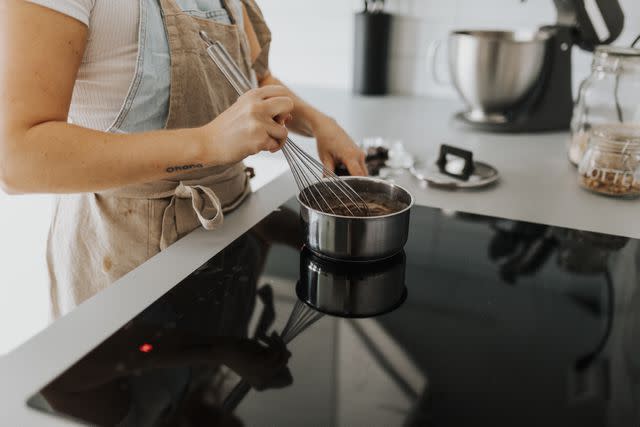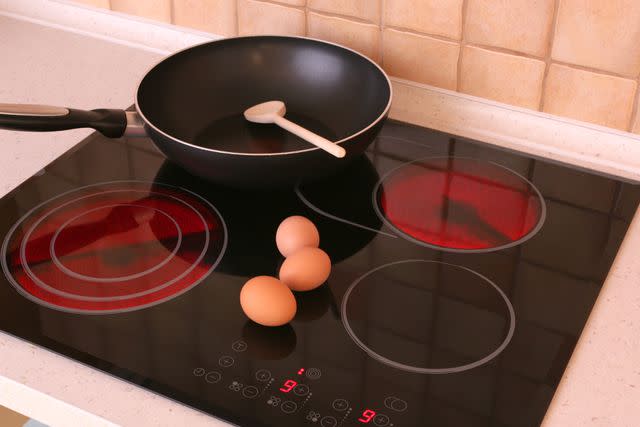Induction Vs. Electric Stovetop: Which One Is Best For You?
Complete your kitchen with one of these picks.

Photo: Tony Anderson (Getty Images)
Ah, kitchen ranges. Arguably the most vital part of any kitchen, these appliances come in several forms, including induction and electric models. Both look the same and operate similarly in the fact they use energy for heating and are flameless when compared to gas stovetops, but they still have their differences to note.
Is it time to upgrade the star of your kitchen? You might be wondering what's different in an induction vs. electric stovetop, or which one would best suits your needs and cooking preferences. "A good cook can adapt to any cooktop," says Amy Hand, a professional chef and writer at The Skillful Cook. "But if you have the chance to choose your stovetop, especially between these two, there are a few factors to consider."
Meet the Experts
Amy Hand is a professional chef and contributing writer at The Skillful Cook.
Samuel Luna is the Director of Product at BKV Energy.
Induction Stovetop

Photo: Johner Images (Getty Images)
Induction stovetops are a type of electric range, but uses energy differently to heat your cookware. These stovetops generate heat through electromagnetic currents from the copper coils found underneath the surface and materials of your cookware.
How does it work? When you place an induction-approved cookware item on the stove (more on this later), and turn the stovetop on, an electric current begins to pass through the copper coils to create heat. With this heating style, pans are heated directly instead of indirectly through a burner.
Pros
Induction stovetops are gaining speed in popularity, and it's no surprise as to why. These stovetops come with several benefits, like being incredibly energy-efficient from their direct heating. "Inductions are 5-10% more energy-efficient than electric stovetops," says Hand. "Since the stovetop only heats when the pan is in contact, you are much less at risk for burns when cooking on an induction."
Another plus to induction stovetops is their quick heating time and precise temperature control. Because of the direct heating, pots and pans heat up instantaneously, which means water will boil or food will sear quicker than they would on a gas or electric stovetop.
The direct heating also comes into play with temperature control since the burner doesn't have to adjust to higher or lower temperatures. Instead, heat responds quickly to your temperature adjustment, so you're always able to monitor your cooking speed safely and accurately.
Need one more reason to consider going with an induction stovetop? Hand says cleaning up after meals is nearly effortless since the glass top is a breeze to clean, which definitely sounds like a win to us!
Cons
We know how wonderful saving on energy and cleaning ease sounds, but there are a few cons to induction stovetops to be aware of before making a purchase. One of the biggest is compatible cookware.
"Unfortunately, you can't use any cookware on an induction stovetop," says Hand. "The pan plays a vital role in completing the electromagnetic circuit for heating, so it's essential that the pan is made from a magnetic (ferritic) metal to work with induction stovetops. This includes metals like cast iron, and stainless steel."
Though you have the nod of approval to continue using your beloved cast-iron skillet for cooking on these stovetops, Hand does provide a warning. "The glass surface is also easy to scratch with heavy cookware like cast iron, so just be careful."
Price is another con to induction stovetops. Induction stovetop come with higher prices than gas or electric counterparts because of the special technology it uses to heat. "Some models can cost up to $2,000," says Samuel Luna, the Director of Product at BKV Energy.
But, if you can accept the higher up front costs (and don't have to fork out extra money for compatible cookware), these stovetops could save you money on the back end from their energy savings.
Related: How To Clean A Glass Stovetop, According To An Expert
Electric Stovetop

Photo: tomazl (Getty Images)
Electric stovetops also have coils underneath the glass surface, but the heating technology is different. Their heating uses these coils (when turned on) to heat the actual glass instead of the pan. Once the glass surface is heated, then pan becomes heated and cooking begins, so heat is generated indirectly.
Pros
Being that electric stovetops are one of the most common types of ranges found in most homes, there's several pros to enjoy with these cooking appliances. One of them is their lower prices. "Electric stovetops are less expensive to install and you can use essentially any cookware while you're making a meal," says Luna.
Their wide range of cookware compatibility takes away the need to shop for specific pots and pans that you may not already have, which saves more money on the overall purchase.
Additionally, the simplicity of these stovetops is another reason as to why they're a fan-favorite. Electric stovetops are easy to use and simple in terms of heating. Because of this, they're more affordable, which is a great perk if you need to replace your cooktop fast and don't have time to shop at a leisurely pace.
Cons
On the flip side, electric stovetops use more energy, which means you could see higher energy bills with these picks.
According to Luna, electric stovetops are not as energy-efficient and have a 16% less energy-efficiency rating. Some heat is lost through the heat transmission from the coils to pan and because of this, temperature heating times are also slower. Pots and pans will take longer to heat on these cooktops than they would on an induction one, which also means they are equipped for precise temperature control.
Comparing Induction vs. Electric Stovetops
Still trying to decide between an induction vs. electric stovetop? Let's compare their important qualities and features to help you make the right pick.
Heating Speed & Efficiency
Induction and electric stovetops both heat with energy, but their energy heating differences affect their speed. Induction stovetops heat fast than electric stovetops since their heat is more direct. Electric stovetops heat the burner first and then the heat transfers to the pots and pans, so it's a much slower process.
Also, the direct and instant heat produced by induction stovetops provides even cooking. Since electric stovetops take longer for the overall cookware to heat, cooking temperatures are more dispersed.
Temperature Control & Responsiveness
Once again, induction stovetops are the better choice for temperature control and responsiveness. Both stovetops are operated with controls for heating temperatures, but electric stovetops have a longer time adjusting to the change in temperature because of their indirect heat. Whether you increase or decrease the temperature on an electric stovetop, the burner has to adjust before it impacts the cookware.
On an induction stove, the process is instantaneous. These stovetops are quicker to respond to changes in cooking temps, which gives you complete control over hot hot the pot or pan is.
Energy-Efficiency & Cost Savings
Both stovetops have pros and cons when it comes to costs associated with energy-efficiency. "Induction stovetops are significantly more energy efficient than electric stovetops. They are 90% efficient compared to 74% for electric," Luna says. Whereas electric stovetops lose energy from the transmission from the burner to the cookware, induction stovetops hardly waste energy. This saves you on your monthly energy bills, but be prepared for higher product and installation costs.
With electric stovetops, cost and efficiency is reversed. Electric stovetops are more affordable upfront and are a great budget-friendly option, but they won't save you money on your monthly energy consumption.
Cookware Compatibility
Electric stovetop is more forgiving in the type of cookware you can use on their surfaces when compared to induction stovetops. The sky's the limit when cooking on an electric stovetop, but induction stovetops require pieces like stainless steel or cast iron in order for the top to heat correctly.
Safety Features
Induction stove's are built with an incredible safety feature that won't heat the surface if you turn it on and forget to sit your cookware down. Since heat on induction stovetops need the right cookware to begin heating, the top is safe to the touch when turned on and without the pot or pan on the burner.
Electric stovetops have a similar feature in the form of an automatic shutoff. It's important to note that electric stovetops are not as safe if they are turned on and missing cookware. Once you turn on an electric stovetop, the top will begin to heat to your temperature setting and you do become more susceptible to burning.
However, these appliances usually come with an automatic shutoff timer that will turn the stovetop off when the time is up or incase of a spill. Be sure to read the manual first to see if your range includes this feature and how to use it safely.
What To Consider When Choosing an Induction or Electric Stovetop
Before you settle on a new stovetop, both of our experts say there are a few elements to each option to weigh out. "Readers should evaluate their budgets, their current electric bills, and think about what they are willing to invest in a new stovetop before they make a decision," says Luna. "Choosing the right stovetop for your home incorporates several factors: the cost of installation, energy efficiency, impact on your electric bill, and your ability to cook a quality meal in a reasonable amount of time with the kitchen cookware already at your disposal."
If you're currently using a gas stove and thinking of switching to induction, wiring is another factor to consider. Gas ranges typically use a 120-circuit whereas induction ranges require high-capacity wiring and a 220-volt outlet. If you already have an electric stovetop, you shouldn't need to alter your wiring, though it's never a bad idea to check with a professional to cover your basis.
Choosing between an induction or electric stovetop boils down to energy efficiency and costs. If you want to improve your monthly electric bill and are prepared for high initial costs, then an induction stove would be the best pick. If you need a new stove and want to stay with a friendlier budget, an electric stove will suit you best.
Just remember that all induction stovetops require special cookware, so if this is the route you choose, don't forget to treat yourself to a new cast iron skillet or stainless steel set!
Frequently Asked Questions
What is the main difference between induction and electric stovetops?
Induction stovetops contain coils that react with metals in your cookware to produce heat whereas electric stovetops use coils to heat the burner and then your cookware. Induction stovetops provide direct heat to the pan while heating in electric stovetops is indirect, which makes their heat time much slower.
Are induction stovetops more energy-efficient than electric stovetops?
Induction stovetops are far more energy-efficient than electric stovetops. That's because your cookware syncs with the coils to transfer heat between each other when the stove is turned on. Heat is hardly lost during the process compared to the extra heat lost in electric stovetop heating.
Can I use any cookware on an induction stovetop?
Induction stovetops require specific cooking materials, like cast iron or stainless steel, that are made with particular metals to react with the copper coils underneath the cooktop's surface. These materials cause a magnetic reaction that leads to the transfer of heat when the cooktop is turned on.
Are electric stovetops easier to clean compared to induction stovetops?
Electric stovetops with drip pans can be a hassle to clean compared to the smooth glass surfaces of induction stovetops. Drips and spills that burn on electric stovetops also have a bad habit of being incredibly hard to remove without the help of a degreaser.
Do induction stovetops require special electrical wiring?
Induction stovetops only require special electrical wiring if you're switching from a gas oven. If you've been using an electrical stovetop, you likely don't need to change your wiring.
For more Southern Living news, make sure to sign up for our newsletter!
Read the original article on Southern Living.

